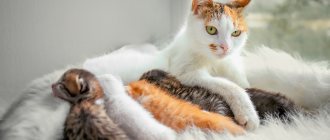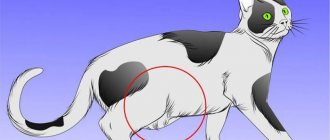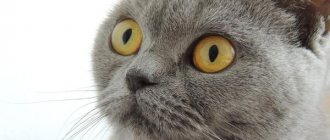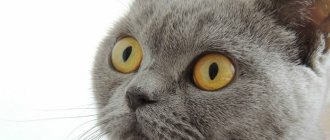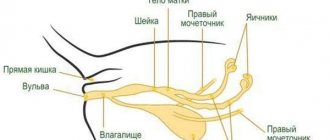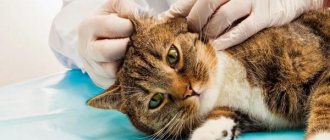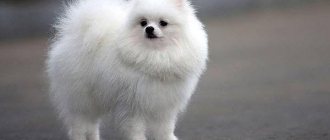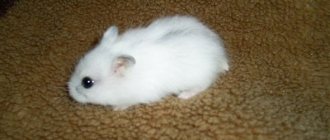10218Administration
Quite often, owners of British cats are faced with pregnancy in order to procreate their pet. After all, many have repeatedly dreamed of breeding large offspring. And when this happened, the question arises about how long pregnancy lasts in cats of the British breed, since very often, without knowing about the term and time, how long your pet needs to walk, there are cases of unplanned birth. And if complications arise, which are almost impossible to foresee, then the owner is unlikely to be able to do anything.
Other characteristic features
Changes in the behavior of the cat itself are also observed. During pregnancy, short-haired British darlings turn into calm, quiet and gentle animals. They avoid sudden movements and are more likely to stay indoors than outdoors. In addition, they need support from the owner and they often remind him of this.
© shutterstock
A British woman requires special attention in the second half of pregnancy. After all, the reason for this is the manifestation of such signs precisely after 6 weeks.
In recent days, British pregnant cats walk very carefully, in order not to harm the small lumps. Also, at the end of gestation, animals begin to look for a suitable place to give birth.
Home birth
By prior arrangement with your veterinarian, you can call him as soon as you notice that labor is approaching. Ideally, he will only be required to be present, but if problems arise, his help may be indispensable. You will also need to prepare a birthing box, absorbent diapers or cotton towels. You will need scissors and alcohol, a lot of clean cloth, it is advisable to purchase oil vitamins like “Gamavita” in advance. Additionally, stock up on Vaseline oil and warm water, as well as a heating pad for newborns.
The birthing area must be clean and dry, otherwise the kittens may die from dampness and cold. The temperature must be at least 29 degrees. A heating pad is placed in the nest for this purpose, but a cooler place is left for the cat to crawl away. Knowing how long pregnant cats (British Folds) walk will help you prepare for the event in advance and gather everything you might need.
Many kittens - how it happens
The duration of pregnancy for British pets is on average 9 weeks. And during this period, the animal can bear 5 or even 6 kittens . The reason for this is the exceptional features and shape of the uterus.
© shutterstock
After mating, eggs are formed in the cat’s body within 23-30 hours, the average number of which can reach up to 6. Therefore, there is a high probability that your British pet can give birth to so many kittens.
What does (low) multiple pregnancy depend on?
There are both a huge number of hypotheses and scientifically proven facts on this matter. Our topic is not a dissertation for an academic degree, so we will lump all theories and evidence into one common pile.
- Proper and nutritious nutrition has an important influence on conception, subsequent pregnancy and childbirth: the worse a cat eats, the less likely it is to become pregnant. There is such a thing as nutritional infertility - in this way nature tries to prevent the appearance of non-viable or sick offspring.
- The weight of the pet also plays an important role in the production of eggs and subsequent pregnancy. It is well known that obese females not only do not become pregnant, but they, in principle, do not go into estrus - what kind of multiple pregnancy can we even talk about in this case?
- Living conditions: comfort, warmth, cleanliness, lack of stress, etc.
- Hereditary factor: if a cat was born from a low-fertility mother, then the likelihood that she will also produce “a little” kittens is very high!
- A history of infectious diseases that somehow affect the development of reproductive function.
- Diseases of the reproductive system and injuries also affect the number of eggs produced.
- The temperament of a cat, no matter how strange it may sound. After all, it is well known that ovulation in cats occurs at the moment of coitus, and the sexier the male is, the more he cares for the bride, the more eggs will be released.
- Incompatibility with the opposite sex, which also occurs in humans. So, for example, there lived an allegedly infertile cat who was in heat, and they bred her with three different cats, but there was no effect. Until her permanent fiancé appeared in her living space. Apparently, the every minute presence of the cat, its smell, awakened hidden possibilities in the “woman’s” body.
- Let’s remember once again about cats, or more precisely about the quality of their sperm. The weaker the sperm, the smaller their number, the more underdeveloped among them, the less the chance of getting healthy, and most importantly, multiple offspring from a healthy cat. In turn, the quality of sperm depends on the nutrition of the reproductive system and the frequency of its use (both excessive use and abstinence have a negative impact on reproductive function).
- Low hormonal levels of the expectant mother, when the follicles produce few eggs ready for fertilization.
- Long-term use of antisex hormones will not only affect the number of offspring, but also its viability. Most often, a cat mated after such therapy brings 1-2 kittens, while they are weak or not at all capable of life outside the womb.
- Individual characteristics of the body, size, weight, age, etc., etc.
- Breed is another factor. For example, outbred cats can give birth to many kittens in the first, subsequent, and very last pregnancies. Whereas blue-blooded animals rarely bring more than 5.
- It is believed that the number of matings affects the number of kittens. Allegedly, after the first mating, the animal brings 1-2 kittens, by the seventh it reaches its natural maximum, and after that the number of offspring decreases again.
- Another theory, more like nonsense, says: the sooner insemination occurs from the start of estrus, the more kittens will be born.
Second three weeks
At this stage, a very rapid progression of pregnancy in a British cat can be observed. The embryos become larger and can be felt in your pet's belly, but the exact number of kittens is still impossible to determine.
The middle part of this period is characterized by a significant increase in the abdomen due to the rapid growth of British babies. And already at the end of 6 weeks, the uterine cavity is filled with liquid, thanks to which it is almost impossible to determine the exact number of future kittens.
© shutterstock
The main pathologies of pregnancy that affect timing
In animals, by nature, everything is built in such a way that basic physiological processes proceed perfectly without human intervention. Domestication has led to the fact that deviations in the bearing and birth of offspring in domestic pets have become increasingly common. This also changes the cat's pregnancy time. What kind of pathologies are these?
Superfetation
This is a fairly rare pathology, characterized by the appearance of estrus (sexual activity) during the current pregnancy. This is a type of hormonal imbalance. If in this state the cat is not protected from the male’s covering, then simultaneously with the main litter, another “batch” of embryos will begin to develop in the womb. It turns out that the fruits from both fertilizations simultaneously develop in the body, but with a difference in development weeks.
The situation usually develops in two ways:
- the first “batch” of kittens is born on time, the second “batch” remains in the womb, and pregnancy continues further along with breastfeeding of newborns. Such cases have only one drawback - there are not enough nipples for everyone after two births, so the owner will have to do the feeding. This is an ideal development and it happens very rarely;
- During the birth of the first kittens, miscarriage occurs and the second ones die due to their underdevelopment - this happens in most cases.
False pregnancy (“spoon”)
This pathology is distinguished by the fact that there are no kittens in the womb, but in appearance and behavior it seems that the cat is pregnant: an enlarged abdomen is visible, the mammary glands swell and turn red, and colostrum appears. The catch is that the duration of the “spoon” coincides with the usual time intervals. There is only one difference - the babies do not appear at the set moment. The deviation is hormonal in nature. Most often the condition occurs in Sphynxes and Orientals. It is imperative to contact a veterinarian, because... this pathology leads to inflammatory processes against the background of stagnation of blood in the genitals and severe mastitis.
Owners should pay attention to:
- absence of labor on the due date;
- a little earlier, the absence of fetal movements.
The cat has ascites and looks pregnant
An accurate diagnosis is always made after an ultrasound. Treatment is complex, including normalization of hormonal levels and treatment of concomitant diseases.
Ascites
The exact cause of this pathology against the background of false pregnancy is not known. Experts are more inclined to believe that due to hormonal imbalance, protein metabolism is disrupted and fluid begins to accumulate in the abdominal cavity.
The belly is growing, the owners think that Murka will soon have kittens, but the absence of kicks from the babies in the later stages and behavioral signs in the cat is alarming. Those. There is nothing else except a big belly.
This is already a reason to contact a veterinarian to examine your pet. Ultrasound will be especially informative in this case. The condition, unfortunately, is incurable.
Frozen pregnancy
A serious pathology that occurs against the background of arrested development and death of fetuses in the womb of a cat. There are many reasons for this condition:
- infections,
- hormonal deficiency,
- various inflammations in the abdominal cavity and pelvis,
- injuries
- stress.
Any attentive owner can determine this:
- the belly is not growing;
- there is no movement of the fruit;
- appetite decreases, the cat becomes lethargic and inactive;
- at the beginning of decomposition, signs of general intoxication and self-poisoning appear with fever and vomiting.
Be sure to go to the clinic. An ultrasound is done. If it is confirmed that all the babies are dead, then the cat is aborted in the clinic. If it turns out that there are live fetuses, maintenance therapy is prescribed at the discretion of the veterinarian in order to gain time, allow the living fetuses to develop further, so that Murka gives birth on her own on the set dates. Usually, after such a pathology, it is suggested to carry out sterilization. The risks of relapse are high due to the inability to know exactly why this happened and the lack of ability to prevent a recurrence.
Ectopic pregnancy
A condition in which the egg is implanted in the wrong place and the fetus begins to develop outside the uterus. Outwardly, this state does not manifest itself in anything until a certain time. This often leads to rupture of the main “pregnant” organ, and this, in turn, leads to serious bleeding and intra-abdominal inflammation. The cat requires urgent surgical care. In difficult situations, in order to save Murka from sepsis and necrosis, a caesarean section with sterilization is performed (the animal will not produce any more offspring).
Miscarriage
This is a spontaneous termination of pregnancy in the early stages, when the fetuses are not yet viable and cannot be saved.
There are three types when
- embryos stop developing very, very early and are resorbed.
- kittens die and leave the cat's womb through premature birth.
- the fetuses die, but remain in the womb until the end of the “pregnant” period.
Any of these conditions is pathological, which is not always possible to predict. Often this happens suddenly and the owners are late in seeking help. In all cases, the fetuses die, the only difference is at what period of the cat’s pregnancy.
You can suspect a miscarriage based on the following signs:
- foul-smelling discharge appears from the genitals;
- persistent asymmetry of the abdominal walls;
- feverish state, fluctuations in body temperature;
- refusal to eat, vomiting, sudden weight loss;
- inexplicable anxiety.
Final stage
At the beginning of the 7th week, the pregnancy of a pet of the British breed has some peculiarities. In particular, you can feel the babies’ heads well and feel their movements. The cat's large size does not allow it to walk quickly , so it moves very slowly. The behavior of the British pet is also changing, which is expressed in greater attachment to its owner, the so-called “following.”
A few days before giving birth, anxiety appears in the animal's character, and the search for a place to give birth begins. Basically, it should be a secluded and cozy corner.
Most owners of British cats take a crate or box in which they need to create a place for small kittens and their mother.
A necessary point in this period of pregnancy is radiography and ultrasound. The purpose of this procedure is to study information about the number of fetuses and their placement in the uterus. And if some kittens are in the wrong position, then this will need to be taken into account during childbirth.
Mating
Only purebred animals can be bred. The cat will not give birth: it is necessary to choose a doctor to sterilize the animal. Usually the procedure is performed after the end of the acute period of estrus. The client is given sedative drops to alleviate the condition. Important: do not use hormonal drugs that cause serious disturbances in your pet’s fragile body without a veterinarian’s prescription.
14 days before the event, it is necessary to give the cat anti-worm medications and check the pets for all necessary vaccinations. It is necessary to carry out hygiene procedures: trim the claws. It is not recommended to wash it just before mating: a household product will remove the natural odor of the animal.
When to breed
After the first heat begins, they skip another one and then only find a British cat for mating. It is forbidden to bring a gentleman without waiting for the right time, the third heat. The consequences of non-compliance with the rule are sad: a miscarriage may occur, kittens will be born weak or dead.
Choosing a partner
One of the important points in choosing a partner for mating is whether the British cat has experience. The animal must be suitable in age and size. External characteristics, color and color, advantages and disadvantages of the individual, compliance with the breed standard, take into account all the data. Pay attention to the absence of diseases in the cat; strong offspring are born from healthy parents. It is better to choose a cat from your club.
A British Shorthair cat should be bred to a British Shorthair cat. It is most often not recommended to take a long-haired cat for mating. In most structures, offspring are considered marriage. To participate in exhibitions, they will find out in which system the pet is registered.
How does mating work?
The successful outcome of mating British cats depends largely on the behavior of the girl. The fluffy beauty is taken to the male’s house, or to neutral territory. In his own home, the cat behaves more confidently, and the process will go faster.
If the ward does not like the partner, the mating does not work out. A girl can show aggression, bite a cat, scratch a person who is nearby. Such problems do not always happen, but they do occur during the first experience. And the owner must be prepared for such a situation and not leave his pet immediately after arriving at the British cat for mating.
When the female's behavior does not cause concern, it is necessary to leave the pets alone. The total period that animals spend mating lasts 2-3 days. After this time, the male usually loses interest in his partner.
Diet features
During the entire pregnancy period of a British cat, it is necessary to take care not only of the animal, but also of its nutrition. After all, many owners, having learned about the situation of their pet, think about how to feed it.
The diet of a pet during pregnancy has a number of features:
- increasing the amount of food taken;
- variety of foods consumed;
- your daily diet should contain foods that contain a lot of protein;
- Food rich in minerals and vitamins will also be beneficial.
Caring for a pregnant cat
A pregnant British woman requires increased attention from all family members. Knowing the reason why British cats do not like to be held, you can learn how to communicate with the animal during pregnancy. An aristocratic person in ordinary times does not always accept signs of attention from the owner. But while waiting for the babies, she becomes more affectionate, sometimes following on their heels, making loud rumbling sounds.
Proper nutrition
During pregnancy, it is especially important to provide adequate nutrition. The menu is more nutritious and varied. Divide the amount of food intake into 5 times. They use industrial food specifically for pregnant British cats, containing a vitamin and mineral complex. What to feed a pregnant British cat on natural food: be sure to include in the diet:
- Lean meat.
- Vegetables.
- Cereal porridge.
- Fish (no more than 1-2 times a week).
- Additionally, they buy a complex of vitamins.
- Eggs.
- Cartilages.
What do we have to do
For a successful result, for the appearance of healthy kittens and support for the animal, a number of measures are carried out:
- monitor the health of your pet: if there is diarrhea, increased body temperature, or the appearance of discharge, you should urgently contact a veterinary hospital;
- control the weight of the British: it is important not to overfeed the animal.
- arrange a convenient place for childbirth: a box, a crate. The cat is shown a place and placed on a bed;
What not to do
- do not pick up the baby. If the girl herself unexpectedly wants to be closer to the person, stroke carefully, without pressing on the abdominal area;
- do not allow the expectant mother to climb high, limit access to objects near the ceiling;
- do not allow yourself to arrange a place for childbirth: the animal will ruin linen and clothes;
- Do not prescribe medications to your pet; use medications only as prescribed by a veterinarian;
- exclude factors that traumatize the animal’s psyche: loud music, noisy outdoor games.
After 3 months
But already at 3-6 weeks of pregnancy, a British pet needs to be given 40-50% more food. The reason for this is the rapid growth of fruits and due to this the amount of food consumed increases. It is also during this period that you need to include a lot of protein in your pet’s diet, which will be very necessary during lactation.
© shutterstock
In the last weeks of pregnancy, your British cat may experience a decrease in appetite. This is due to the large size of the fetuses, which occupy a significant part of the abdominal cavity.
Therefore, you need to reduce the amount of food consumed and increase the frequency of its intake.
Puberty
British cats are called late breeders. Their puberty can take up to 11 months: each animal has its own developmental path. On average, plush pets mature at the age of 1 year. But in some children, initial signs appear at 4-5 months.
Estrus
The first heat of a British cat, according to the observations of British owners, begins at 7-9 months. During this period, inexperienced owners are lost and do not know what and how to help the animal. The cat screams, arches its back, raises its tail, and becomes restless. Experienced breeders know how long estrus lasts in cats of the British breed: it can last about 3 days to a week.
Recurrence of symptoms can be observed after 2 weeks if the animal is not taken for mating. The giving birth adult asks for attention from the male every three months. Don’t be afraid: the clinic’s specialists will explain how often British cats go into heat, or you can ask the owner of the cattery for advice.
It happens that the baby refuses to eat, loses weight, sheds intensely, and organizes concerts at night. Both the animal and family members suffer. Therefore, when planning to buy a British cat, you need to immediately decide: the pet is being taken for breeding or the owner does not intend to breed and, in the future, sell kittens.
What does the diet look like during pregnancy?
Nutrition is an important part of your pet's life, especially in this position. Therefore, you need to familiarize yourself in advance with the basic principles that you need to know and follow when feeding. After all, pregnancy in a British cat can have complications due to poor nutrition. Therefore, you need to add to your diet:
- cereals and raw vegetables (carrots, cabbage), which can be discreetly mixed with your pet’s favorite food;
- It is important to give dairy products at the end of pregnancy because of the large amount of calcium they contain, which is necessary to strengthen the bones of kittens;
- boiled cartilage, thanks to which your British pet will receive a significant amount of vitamin D;
- In addition, you need to give other vitamins, especially groups A and B.
© shutterstock
What is not allowed in an “interesting position”?
The owner of a British cat expecting the birth of kittens should avoid the following:
- Treat her with any medications without first consulting a veterinarian.
- Overfeed your pet, as excess weight can cause complications during childbirth.
- Ignore health problems, especially high temperature, loose stools, vaginal discharge with an unusual smell and color. If any alarming symptoms appear, it is necessary to show the British woman to a specialist.
- Allow actions that can frighten the cat and make it nervous (too active games, listening to loud music, etc.)
